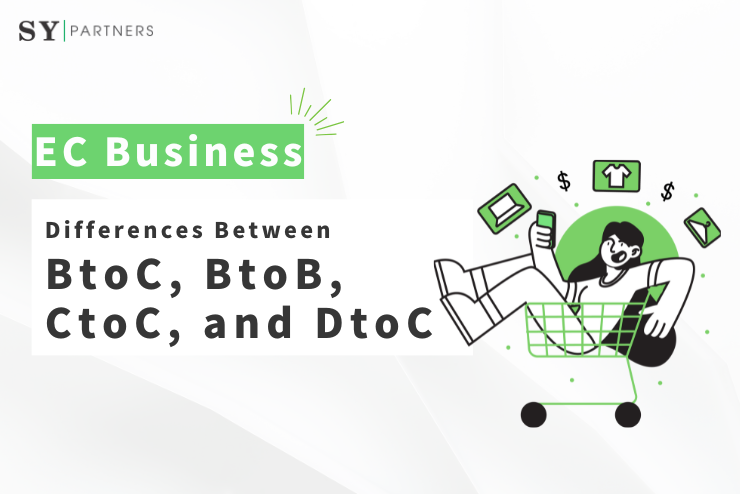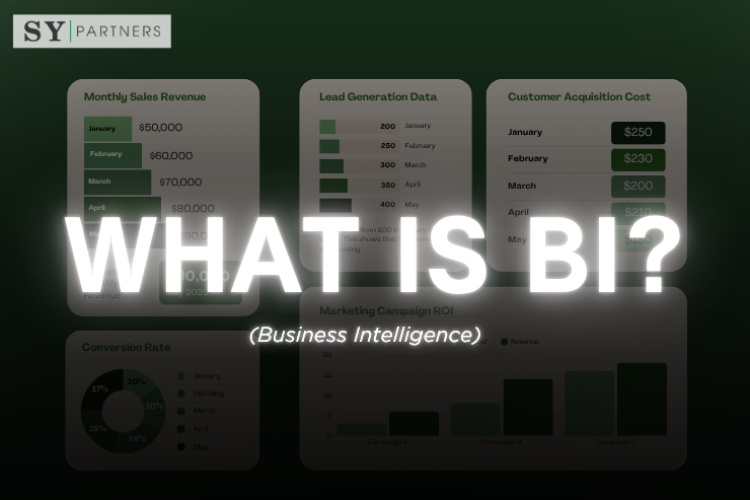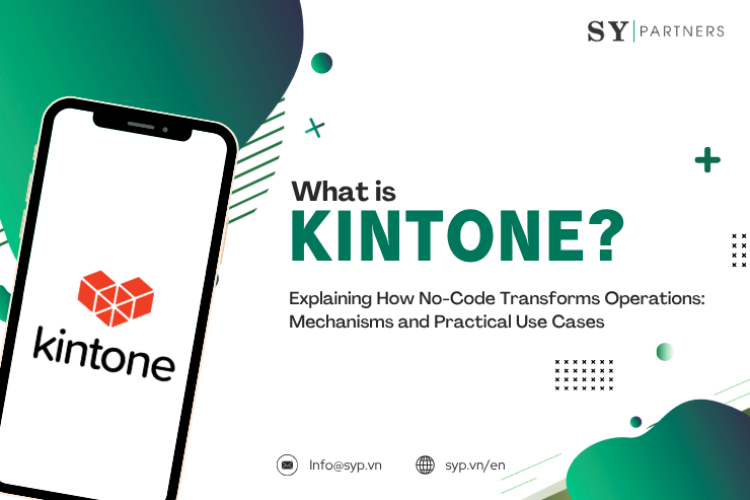A Thorough Guide to the Four Major EC Business Models|Features and How to Choose Among BtoC, BtoB, CtoC, and DtoC
EC (e-commerce) sites are the foundation of modern business, using the internet to sell products and services. As markets and customer needs diversify, choosing a business model that fits your company is essential for success in EC.
This article explains the four representative EC business models (BtoC, BtoB, CtoC, and DtoC) in an easy-to-understand way for beginners. Through their features, pros and cons, and concrete examples, we provide hints for finding the optimal model for your company.
1. What is an EC site business model?
Selecting the right business model is critically important for making an EC site successful. The “structure of transactions”—which customers you serve, what value you deliver, and how you deliver it—has a significant impact on site design and operational policy.
An EC site business model is the concept that shows sales formats and targets in online commerce. Concretely, it organizes “who sells,” “to whom,” “what,” and “how,” and can be considered the starting point of business strategy.
Representative models include BtoC (company → consumer), BtoB (company → company), CtoC (consumer → consumer), and DtoC (manufacturer → consumer). Each is used to address different market needs, and you must choose the appropriate model based on your products and customer segments.
2. Why business models matter
In EC sites, the business model is a crucial factor that significantly influences operational policy, marketing strategy, and revenue structure. Here, we explain why business models matter from three perspectives.
2.1. Clarifying the target customer
The target customer segment varies greatly depending on the type of business model.
- BtoC (Business to Consumer) targets general consumers and requires user-friendly design, diverse payment options, delivery options, and more.
- BtoB (Business to Business) is premised on inter-company transactions and needs functions that support bulk orders, quotes, and ongoing transactions.
By clarifying the business model, you can implement the optimal approach aligned with customer needs.
2.2. Optimizing the revenue structure
Each business model differs in how revenue is obtained and in its cost structure.
- In DtoC (Direct to Consumer) models, eliminating middlemen makes it easier to raise profit margins, but acquisition and marketing costs increase accordingly.
- In CtoC (Consumer to Consumer) models, the platform acts as an intermediary and typically earns fees from transactions between sellers and buyers.
Understanding the revenue structure by model enables profit maximization and operational cost optimization.
2.3. Responding to the competitive environment
Business models also affect the style of competition and how you compete in the market.
- In BtoC models, price competition with peers tends to be intense, so differentiation through product lineup and service quality is necessary.
- In DtoC, you can differentiate not only on price, but also through brand worldview and customer experience.
For example, in a BtoC-type EC mall like Rakuten Ichiba, many competing stores coexist on the same platform, so how you convey your products’ appeal becomes important.
3. BtoC (Business to Consumer)
A company sells directly to general consumers—this is the most popular EC model. The core is daily-life products such as apparel, food, and cosmetics, and optimizing customer touchpoints is the key to growth. Below, we examine features, advantages, challenges, and success factors in detail.
3.1 BtoC Features
Extensive product assortment
It’s common to expand SKUs horizontally/vertically in line with lifestyle diversity—from apparel and daily goods to appliances and subscription food. When aiming to differentiate from competitors, it’s essential to secure “depth,” including long-tail items, while avoiding overstock through accurate demand forecasting.
Intuitive UI/UX
Mobile-first design, AI search, AR try-on—“guidance that doesn’t let users get lost” is emphasized. For example, one-tap purchase and Apple Pay integration often increase conversion rates by several percentage points.
Diverse payments
Covering cards, pay-later, debit, e-money, BNPL, etc. minimizes cart abandonment (especially on mobile). Don’t forget to incorporate chargeback countermeasures, not just international brand fees.
Promotion is key
Beyond distributing coupons and points, real-time tactics like live commerce and SNS-linked flash sales are becoming the main battleground. Stimulating customer FOMO can significantly boost short-term sales.
3.2 Advantages
Huge market
There are sales opportunities 24/7 globally, and cross-border EC can rapidly expand your customer base. Everyday items are purchased frequently, making it easy to build LTV (customer lifetime value).
Data capture
By centrally managing behavior logs such as browsing, exits, and cart abandonment in addition to purchase history, you can deliver highly accurate recommendations and personalization. Running A/B tests by customer segment accelerates the PDCA cycle for CVR improvement.
Flexible marketing
Omnichannel tactics combining SNS, email, push notifications, and retargeting ads are mainstream. By considering the entire customer journey and sending appropriate messages at each touchpoint, you can sustainably raise repeat rates.
Fast PDCA
The cycle of review analysis → product improvement → additional campaigns is short, making it easy to reflect customer feedback directly. For example, revising the size chart based on reviews like “runs small” reduced return rates by 10% in some cases.
3.3 Disadvantages
Price competition
Prices are instantly compared on comparison sites and Google Shopping, so gross margins are easily squeezed for products lacking clear differentiation. If uniqueness is weak, you need to compensate with value beyond price—like shipping options and fastest delivery.
Customer support costs
A two-tier support structure of chatbot + human agents for returns/exchanges increases personnel costs. Expanding FAQs and introducing RPA-based automation are needed to streamline back-office operations.
Rising acquisition costs
Ad unit prices are rising year by year, pushing up CPA. It’s essential to balance with “organic inflow” like SEO, UGC, and affiliates.
3.4 Success Factors
UI/UX optimization
Implement page speed improvements, one-click purchase, and chat support as a set to deliver a zero-friction experience. Keeping an eye on Google Core Web Vitals also improves SEO.
Personalization
Segmented emails based on RFM (Recency, Frequency, Monetary) and dynamic banners for tailored proposals are effective. “Personal service” that doesn’t waste customers’ time drives higher repeat rates and average order value.
Delivery enhancement
Hybrid logistics combining in-house warehouses + 3PL + last-mile carriers are mainstream. Thoroughly “visualize” delivery delays and integrate notifications to raise CS (customer satisfaction).
4. BtoB (Business to Business)
An EC model where high-price, bulk transactions are conducted between companies; the mission is to digitize procurement processes and optimize costs. Below we detail functional requirements and implementation challenges.
4.1 BtoB Features
Large-volume, high-value transactions
It’s not unusual for a single order to reach hundreds of thousands to tens of millions of yen. Many purchases are under monthly/quarterly contracts, and quotes/proposals aligned with budget timing are important.
Closed operations
After member login, unit prices are displayed per contracted company, and orders are finalized after an approval flow—so a “multi-tier pricing function” is essential. IP restrictions and SAML-based SSO are also required.
Contract-based
More cases complete the entire flow—quote → internal approval → order → delivery → inspection → invoicing—within the system and store transaction records in compliance with the Electronic Book Preservation Act.
Efficiency-first
Since staff seek “accuracy without spending time,” bulk orders via CSV upload and repeat ordering from past order history are appreciated.
4.2 Advantages
Large market
Japan’s BtoB EC market is said to be about 3–5 times the size of BtoC, and is relatively less affected by economic cycles.
Long-term relationships
Once incorporated into core systems, transactions continue as part of the entire supply chain. Churn rates here tend to be far lower than in BtoC.
Operational efficiency
Digitally migrating purchasing processes that were centered on fax/phone reduces order errors and staff workload simultaneously.
Sales automation
AI proposes demand forecasts and cross-sell products, so sales reps can focus on high-value proposals, optimizing human resources.
4.3 Disadvantages
High initial investment
To reflect complex price tables, approval steps, and organizational hierarchies, you need either a scratch build or a high-function package. Implementation costs can reach tens of millions to billions of yen.
Diverse needs
Specifications differ by company—you must handle requirements like “a different product if one character in the model number changes” or “adjust delivery lots with month-end closing.”
Adoption hurdles
Even if there’s a DX promotion department, actual purchasing operators may be older. Operation manuals and on-site training become a key determinant of success.
4.4 Success Factors
Dedicated systems
Integrate with ERP and inventory systems via API to sync price, stock, and delivery status in real time, enabling “seamless with internal operations.”
Rapid response
Enable one-stop processing—stock inquiry → delivery date confirmation → quote issuance—within five minutes to respond faster than competitors.
Data utilization
Visualize ordering frequency and cycles to improve inventory turnover. During demand spikes, auto-ordering to suppliers prevents stockouts and maintains loyalty.
5. CtoC (Consumer to Consumer)
With the spread of smartphone apps, anyone can be a seller or buyer. The reuse of second-hand goods and the handmade market are growing explosively.
5.1 CtoC Features
Individual-led
Listing can take as little as one minute. Anonymous shipping and QR code payments protect personal information for both seller and buyer.
Platform intermediation
“Safety packages” like AI fraud detection, escrow payments, and convenience-store pickup come standard. When trouble occurs, the operator can more easily mediate.
Diverse products
One-of-a-kind handmade items, vintage pieces, fan merchandise, and other niche items you won’t find in stores circulate here. There are also issues like resales of limited collections, so platform rules are a challenge.
Rating systems
In addition to review comments, shipment speed and packing condition are typically scored on a five-point scale. It’s visually easy to grasp, making it easier even for beginners to trade with confidence.
5.2 Advantages
Easy entry
You can earn side income with zero initial costs, aligning well with household budget reviews and minimalist lifestyles.
Resource utilization
Re-circulating unused items helps reduce CO₂ emissions. Campaigns linked to corporate sustainability initiatives are also advancing.
Flexible pricing
Free from market prices, you can price in “memory value” and “rarity.” Auction formats can lead to high-value transactions.
Community building
In hobby categories (e.g., figures, vintage clothing, records), spaces for users to exchange information emerge, making it easy to increase repeat buyers and followers.
5.3 Disadvantages
Trust risk
For issues like shipping delays or disagreements about item condition, compensation often depends on the platform’s policies and may not be complete.
Fee burden
With 5–10% sales fees plus transfer fees, profits shrink—profitability calculations are essential for high-priced items.
Logistics effort
Since individuals handle packing materials and shipping arrangements, time costs accrue. While convenience-store shipping and mailbox services are expanding, risks of damage/loss remain.
5.4 Success Factors
Building trust
Accumulate high ratings through detailed product photos (multiple angles + close-ups of scratches), honest descriptions, and replies within 24 hours.
Simple operations
Use template descriptions and auto-discount features to streamline listing. Don’t miss price negotiations via push notifications.
Trouble prevention
Always conduct transaction messages on the platform and refrain from external contact to leave an audit trail and reduce the risk of falling outside compensation coverage.
6. DtoC (Direct to Consumer)
A model where manufacturers connect directly with consumers via their own EC sites or apps. The greatest strengths are communicating brand stories and centrally managing customer data.
6.1 DtoC Features
Eliminating middlemen
By not going through wholesalers/retailers, you can realize proprietary pricing and inventory management. You can thoroughly control cost of goods and gross margin, enabling product planning with high-cost structures such as sustainable materials.
Brand storytelling
Convey your “passion” and “story” via your official site, SNS, and owned media to deliver an emotional brand experience. More cases now use video to share craftsmanship and provenance.
Centralized data
By integrating EC + POS + CRM + MA (marketing automation), you can seamlessly leverage data obtained from offline stores and pop-ups.
Personalization
Co-create products with customers through recommendations that reflect body type, preferences, and purchase history, or custom-fit items made with 3D scanning.
6.2 Advantages
High profit margins
Savings from reduced middleman margins can be reinvested in quality, advertising, and customer success, snowballing brand value.
Enhanced brand value
Ethical materials and social-contribution projects clarify reasons to choose beyond price and help form fan communities.
Direct customer data
Identify loyal customers and retain them with VIP programs and subscription boxes. Adjust production quantities based on purchase predictions to minimize inventory losses.
Flexible pricing
You can make swift, in-house decisions on dynamic pricing aligned with demand or early-bird discounts, reducing opportunity loss.
6.3 Disadvantages
Customer acquisition difficulty
Without mall traffic, you must fully leverage owned media, SNS, UGC, and advertising to secure traffic.
High initial investment
You need funds and specialized personnel across many areas: EC site construction, logistics, CS center, content production, and more.
Logistics burden
If you operate warehouse work and returns in-house, scaling to meet sudden order surges becomes a challenge.
6.4 Success Factors
Consistent worldview
Thoroughly enforce brand guidelines and maintain an end-to-end “tone & manner” across product pages, SNS, packaging, and customer support.
SNS integration
Leverage user-generated content (wearing photos, hashtag posts) to cultivate fans via two-way communication. Influencer collaborations and co-branded products are effective too.
Experience enhancement
Improve O2O experiences that span online and offline, such as AR try-on, gift wrapping, and in-store pickup. Achieve both strong word-of-mouth and high repeat rates.
7. Points for choosing a business model
For EC success, selecting a business model that fits your company is essential. Assess the optimal model for your situation from the following four perspectives.
7.1. Business scale and resources
For small businesses and individuals, models that are easy to start with low initial investment—like CtoC or mall-type BtoC—are suitable. For mid-size or larger companies or those with brands, DtoC or BtoB enables long-term revenue and relationship building.
7.2. Target customers
If your target is general consumers, BtoC or CtoC is the default; if it’s businesses, then BtoB. If you want to strengthen your own brand, use DtoC to connect directly with customers. Clarify who you are selling to and then choose the optimal model.
7.3. Marketing strategy
In BtoC and DtoC, online acquisition via SNS and SEO is key. In BtoB, sales support centered on trust relationships and follow-ups with existing clients are crucial. In CtoC, platform reliability and review systems determine success or failure.
7.4. Cost and profit margin
While DtoC and BtoB can aim for high profit, they carry heavier burdens and higher initial investment for in-house operations. CtoC and mall-type BtoC incur fees but are easy to start at low cost and suit small starts. Choose in light of your budget and organizational setup.
8. Summary
The four major EC business models (BtoC, BtoB, CtoC, DtoC) can each be used according to different targets and objectives, greatly contributing to business growth. BtoC is effective for large-scale consumer sales; BtoB for streamlining inter-company transactions; CtoC for promoting person-to-person trade; and DtoC for enhancing brand value.
The key to success is choosing the model that best fits your business scale, target audience, and strategy. Start small and evolve the model flexibly as you grow. With the right EC model, step up to the next stage.
FAQs
Q1. What is the difference between BtoC and DtoC?
BtoC is a model in which a company sells products to general consumers; EC malls and handling multiple brands are common. DtoC, on the other hand, is a model in which manufacturers or brands sell directly to customers via their own channels; it is characterized by the lack of intermediaries and a strategy that emphasizes branding.
Q2. How should we choose the best business model for our company?
Consider the following four points:
- Business scale and resources (large enterprise or sole proprietor)
- Target customers (consumer or business)
- Marketing strategy (SNS/SEO-centric or sales-driven)
- Profit margin and initial cost (in-house operation or mall-dependent)
Organizing these clarifies your direction.
Q3. What should we be careful about when implementing a BtoB EC model?
Key points include handling transactional complexity (price variations, quoting functions, contract-based ordering), integration with existing business systems, and supporting user IT literacy. You should also consider system investment and establishing training programs.
Q4. Can a CtoC business be started as a side job?
Yes. CtoC is easy to start with just a smartphone and is popular as a means of side income or decluttering. However, since you must handle trust building (ratings, responses) and shipping yourself, consistent honest conduct is required for ongoing operations.
Q5. What are the key points for making DtoC successful?
The keys to DtoC success are the following three points:
- Consistently communicating the brand’s worldview (philosophy and story)
- Connecting directly with customers through SNS-linked communication
- Providing continuous experiences through data utilization and personalization
Since you will also handle logistics and inventory management in-house, establishing the necessary organizational structure is essential.


 EN
EN JP
JP KR
KR




